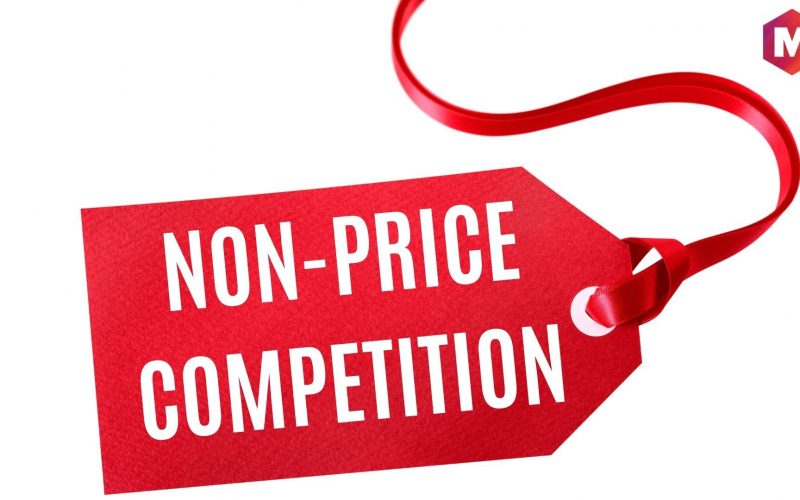Competition in business is unavoidable. In other words, when you think of owning a brand, you should also think of a winning marketing strategy to stay relevant, if not outright defeat your potential competitors out there. In respect to strategy, non-price competition is an example of a winning strategy in terms of marketing strategies that ensure your market relevance.
Non-price competition is a marketing strategy in which your product or service is distinguished from competitors by qualities such as design or something similar.
If you’re a business owner or thinking of owning a business, this piece is for you. Trust me, it’s an ocean of competition out there and you don’t want to get drowned in it.
This article would teach you the definition of non-price competition, as well as its examples and strategies to help you win.
What is Non-price competition?
Non-price competition refers to competition between businesses that focuses on benefits, extra services, good workmanship, product quality, social responsibility and any other features or measures that do not involve changing prices. It differs from price competition, in which competitors try to gain market share by lowering their prices. Non-price competition is frequently used by competing players in a sector to avoid a price war, which eventually results in a damaging spiral of price cuts.
Furthermore, non-price competition is a marketing strategy that typically involves promotional expenditures such as sales personnel, sales promotions, special orders, free gifts, coupons, and advertising.
Phases of Non-price competition
Prices are resistant to change in non-price competition strategies. As a result, in order to maintain your unrivaled market position, you must concentrate your business ideas in the following areas.
#1. Branding and perception
In some cases, there is little room for quality differentiation between two products. In the US, for example, blue jeans have little actual quality variation from one producer to the next. As a result, a number of manufacturers compete by creating a perception of high quality with their brands.
Because consumers see value in the brand itself, some companies can charge higher prices for seemingly identical products. Name brands frequently charge more than store brands for essentially the same grocery staples, such as flour or butter.
However, the long-term viability of such an approach may be difficult because, while such brand advantages emerge as a result of consumer trends, consumer trends may also lead to their demise. For example, if consumers no longer regard a clothing brand as fashionable, the manufacturer may find it difficult to maintain high prices for its products.
#2. Quality
By definition, non-price competition means competing on something other than simply offering lower-cost goods or services. Quality could be one of those things. If a consumer must choose between two products of the same price but can see that one is of higher quality, they will usually choose the higher quality product. As a result, if you can figure out how to produce an item at a cost comparable to what its competitor charges but of higher quality, you may be able to steal the market from its competitor.
Consumers may even pay more for goods perceived to be of higher quality but with similar outward characteristics. This phenomenon benefits Apple, iPhone manufacturers, and organic food producers. However, one disadvantage of this approach is that consumers may not notice any difference in quality for some time.
#3. Design
You may compete in some cases by redesigning your products to make them more appealing without significantly changing production costs or quality levels. Such a strategy can be effective at stealing business from competitors, but it can also backfire by alienating the company’s existing customers. They may be choosing the existing design consciously over other products with different designs because it appeals to their tastes.
Coca-cola’s introduction of New Coke in the 80’s is a clear example of where competition by design didn’t actually work. The product proved unpopular with die-hard fans of the traditional recipe.
#4. Product Differentiation
Not every customer is the same. Markets are made up of men and women of all ages, ethnicities, and socioeconomic backgrounds. As a group, they tend to gravitate toward specific products. As a result, businesses should not anticipate a single product to appeal to all of the market’s consumers.
Firms can broaden their market base by selling a variety of identical items targeted at different market segments. However, product differentiation can lead to much higher production overhead costs.
Examples and Strategies of Non-price competition
Non-price competition strategies include comparing your product to that of a competitor, demonstrating that what you sell has been certified by a reputable environmental organization, and marketing your brand name and logo on a regular basis.
#1. Customization
Customization as an example of non price competition strategy is also helpful. Many businesses now provide products that can be customized to meet the needs of their clients. This is an excellent marketing approach for differentiating products and providing customers with a wide range of options.
Sugar-free, gluten-free, and vegan products, for example, as non price competition strategy are likely to be available to cater to the demands of a certain group of clients. The length, color, and size of the products can now all be customized.
#2. Brand loyalty
Inciting brand loyalty in customers is critical example for all firms as one of the non-price competition strategies. As a result, advertising helps you promote your brand to a considerable extent. When individuals are repeatedly exposed to a brand’s advertisements, they come to trust it. When there is a significant level of brand loyalty, the entrance barriers tend to climb as well.
Brands like Pepsi and Coca-Cola have built a reputation for being trustworthy. Anyone else in the cola sector is now finding it tough to compete with them.
#3. Services for Subsidized Delivery
This is a service-related aspect. Amazon has made a concerted effort in this area. By providing free delivery services, it has successfully influenced consumers’ shopping behavior. Amazon is growing its market dominance by acting as a kind of loss leader. People no longer need to go shopping because they can have things delivered to their houses.
Even other brands are attempting to sell their products using this technique. When compared to the amount paid by customers, the delivery cost is relatively expensive. However, if they increase the cost of shipping, they risk losing a lot of clients. See our post on website creation to find out how you can create one for your business
#4. Agility and Adaptability
This is another example of non price competition strategy. If you’re thinking about starting a business, this is an important consideration. However, if you’re already in business and want to stay above competition using non price strategy, you can put this into practice as well.
Businesses might hit rock bottom if they don’t change their business model to keep up with market trends. Following the old model when the market has changed might, on the other hand, be extremely detrimental to the business.
In such a situation, the ability to adapt and innovate is all that matters. Nowadays, no business can thrive without having an internet presence which is one of the greatest upgrade.
Pros and Cons of Non price competition
Pros
- Non-price competition encourages competing firms to innovate. Nowadays, it is common to see businesses compete through social media posts, various sales tactics, creative advertising, and so on.
- Brands can successfully establish themselves by cultivating a positive reputation among their target audience.
- The products’ quality is not jeopardized, and they are usually subjected to continuous improvement.
- Companies benefit from scope economies by offering a wide range of products.
- Buyers also benefit from the ability to select the product of their choice from a wide range of options.
- Firms’ competition becomes healthy because they are constantly striving to improve their current state.
Cons
- The main disadvantage is that customers usually take their time identifying the changes made, which can be time-consuming.
- A significant amount of research is required to develop various products.
- Customers and competitors may have a disproportionate amount of information about the products.
- Buyers may be unaware of which company can provide them with a higher quality product.
- It may even result in ineffective advertising.
What is non-price competition examples?
Loyalty programs, discounted shipping, unique selling factors, brand awareness, ethical and/or charity considerations, after-sales support, favorable feedback evaluations, marketing initiatives, and many more are examples.
What is non-price competition give examples?
Non-price competition is a marketing tactic that frequently involves promotional investments including hiring sales people, running sales promotions, placing special orders, giving away presents, offering discounts, and advertising. Simply said, it refers to promoting a company’s name and the caliber of its goods rather than cutting prices.
What is price and non-price competition?
To put it simply, brands stand out in non-price competition due to quality, a unique selling proposition, a competitive edge, superior customer service, etc. while items are complete substitutes in price rivalry, which forces enterprises to remain competitive only if the price is lower.
Is perfect competition Non-price?
Perfect competition happens when there are many sellers, easy firm entry and departure, identical products are sold by all sellers, and price takers are present.
What is the most common form of non-price competition?
Advertising is the most prevalent or fundamental non-price competitive strategy. In economics, promotional costs including sales promotions, coupons, advertising, and others make up non-price competition. Additionally, it includes the costs associated with brand management, marketing research, and the development of new products.
What is non-price?
Non-price competition is a business strategy that emphasizes outstanding product quality, a compelling USP, a fantastic location, and exceptional service over reduced pricing as means of luring customers and boosting sales. It aids in brand differentiation and gaining new clients.
Conclusion
To summarize, you’ve seen that nonprice competition benefits businesses by increasing demand for their product or service, in addition to ensuring a larger market share and market power
On the other hand, it benefits consumers by providing them with more, broader, and better options, as well as higher quality/standard goods and services. Simply put, it’s a win-win situation for all parties involved
Related Articles
- 7 Ways to Define you and Define your Business
- DIGITAL MARKETING: Definition, Types and, Strategies
- Financial assets: All you need to leverage effectively (+ best tips)
- Business Strategy: Levels of Business Strategy+10 Best Business Strategy Examples
- Financial Compensation: Definition and Forms of compensation Explained!
FAQ’s On Non Price Competition
What is an example of Oligopoly?
National mass media and news outlets are a prime example of an oligopoly, with the bulk of U.S. media outlets owned by just four corporations: Walt Disney (DIS), Comcast (CMCSA), Viacom CBS (VIAC), and News Corporation (NWSA)
How does MacDonald use nonprice competition?
It claims to buy coffee beans that are ‘fair trade’ and have the ‘Rainforest Alliance Group’ seal of approval. This is an effective way for McDonald’s to boost sales because it does not have to alter the price of the cups of coffee it sells
What are non-pricing factors?
Non-price factors refer to the factors other than the current price that can potentially influence the demand of a service or product and hence result in a shift in its demand curve
What are non pricing strategies?
Advertising, improved service quality, longer hours of operation, and extended warranties are examples of non-pricing strategies. These strategies are essential for oligopolies like the soda industry
What is non price competition examples?
Promotional expenditures (such as advertising, selling staff, the location’s convenience, sales promotions, coupons, special orders, or free gifts), marketing research, new product development, and brand management costs are common in non-price competition






